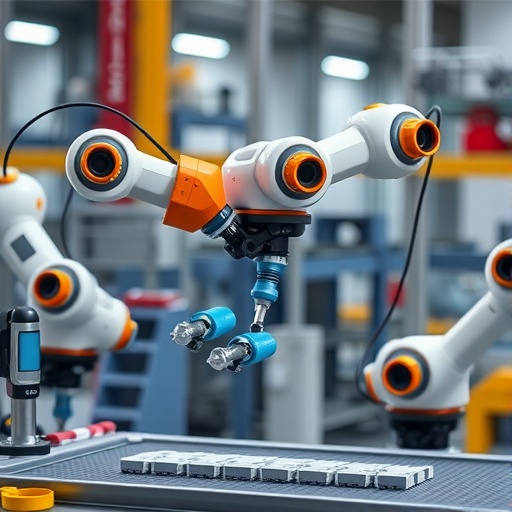Advancements in autonomous robotics are poised to transform manufacturing landscapes, ushering in an era where production is not only highly efficient but also remarkably adaptable and customizable. The capability to coordinate numerous mobile robots within a shared workspace, enabling seamless collaboration among machines and with human operators, represents a formidable challenge. Overcoming this challenge has been the recent focus of researchers at Stanford University, where an innovative algorithm has been developed to translate complex manufacturing blueprints into optimal, robot-driven assembly sequences.
At the core of this breakthrough is an algorithmic framework designed to interpret detailed product design plans and harness a team of autonomous robots to execute manufacturing workflows intelligently. Unlike traditional automated assembly lines, which are often rigid and confined to linear operations, this system embraces complexity by decomposing assembly tasks into subassemblies. These modular components, such as individual car doors in automobile manufacturing, are produced independently before being merged into the final product. This approach offers unprecedented flexibility and scalability by enabling robots to operate both individually and collectively, all while dynamically managing spatial constraints on the factory floor to prevent collisions.
Mac Schwager, associate professor of aeronautics and astronautics at Stanford and co-author of the study, highlights the novelty of this research: “Previous works have addressed isolated aspects of the problem, but the real innovation here is the integration of diverse manufacturing challenges into a single, cohesive large-scale robotic system.” This holistic consideration encompasses everything from task sequencing through to motion planning, which ensures that the entire robot fleet functions cohesively across the assembly environment.
The algorithm’s ability to generate assembly plans rapidly could revolutionize manufacturing by infusing agility into traditionally inflexible production lines. Conventional assembly setups excel at repetitive, high-throughput manufacturing but falter when adaptation or customization is demanded. By leveraging a modular manufacturing philosophy paired with general-purpose robots equipped for a variety of tasks—including welding, sanding, and material handling—factories could soon reconfigure operations swiftly, drastically reducing downtime and retooling costs.
Dylan Asmar, a Stanford PhD candidate and co-author, explains the practical advantages of this modular strategy: “Today, switching from assembling one product to another often entails extensive re-planning and physical modifications on the production floor. Our approach aims to streamline this process, enabling manufacturers to reprogram their construction pipelines on-demand with minimal disruption.” This capacity presents enormous potential for industries targeting mass customization without sacrificing scale or quality.
To actualize this vision, the research team devised an algorithm capable of processing multiple parameters, including the number of robots available, individual robot load capacities, and a comprehensive schematic of the desired product. The algorithm strategically decomposes the product into manageable subunits and assigns effective task distributions across the robot team. It plans pick-and-place operations, coordinates team maneuvers for transporting bulky components, and schedules assembly station activities to optimize throughput.
According to Mykel Kochenderfer, an associate professor and senior author, “Our objective is to minimize the total production time by embracing parallelization. Rather than processing assemblies sequentially, we direct robots to perform concurrent operations wherever feasible, effectively leveraging the collective capability of the robot fleet.” This multi-threaded execution reduces bottlenecks and accelerates overall manufacturing cadence.
Beyond task planning, the algorithm addresses spatial management by meticulously mapping robot trajectories to avoid collisions and traffic conflicts on the factory floor. This includes dynamically rerouting robots as needed, an essential feature as the scale and complexity of the robot team grow. Remarkably, the system demonstrated an ability to compute an assembly plan for a model Saturn V rocket, consisting of 1,845 parts subdivided into 306 subassemblies, utilizing a team of 250 robots—all generated in under three minutes.
Recognizing the challenges remaining before industrial deployment, the team also developed an open-source simulation platform to facilitate further experimentation. Kyle Brown, the lead author and doctoral candidate, emphasizes its utility: “Our simulator enables researchers worldwide to test novel assembly algorithms or refine existing ones, using standardized toy construction block models as benchmarks.” This platform accelerates innovation by providing a common framework to evaluate performance under various constraints and optimizations.
Brown’s team has employed the simulator in educational settings as well, adapting the speed of robotic actions so that elementary school children can race against robots to build simple structures like model airplanes. This interactive experience fosters early interest and demystifies robotic automation for younger generations, potentially inspiring future careers in robotics and engineering.
Though practical application in commercial manufacturing will require further refinement—including robustness against real-world uncertainties and seamless human-robot collaboration—the Stanford team’s integrated approach represents a significant stride into the future of autonomous production. By merging sophisticated algorithmic planning with modular, multi-robot assembly systems, this work charts a path toward highly flexible, efficient factories capable of meeting evolving consumer demands.
As the manufacturing sector faces growing pressure to adopt Industry 4.0 paradigms, solutions like this are vital. They enable not only mass production at speed but also on-demand customization and rapid adaptation, qualities essential for competitiveness in a dynamic global economy. The promise of autonomous robot swarms, orchestrated through intelligent planning algorithms, offers a glimpse into a new manufacturing era—one where efficiency is matched by agility and where the boundary between design and production blurs into seamless automation.
Subject of Research: Autonomous multi-robot systems for large-scale manufacturing assembly planning
Article Title: Large-scale multi-robot assembly planning for autonomous manufacturing
News Publication Date: 10-Sep-2025
Web References:
References:
- Schwager, M., Asmar, D., Kochenderfer, M., Brown, K. et al., “Large-scale multi-robot assembly planning for autonomous manufacturing,” Robotics and Autonomous Systems, 2025.
Image Credits: Stanford Intelligent Systems Laboratory
Keywords: Autonomous robots, Manufacturing




